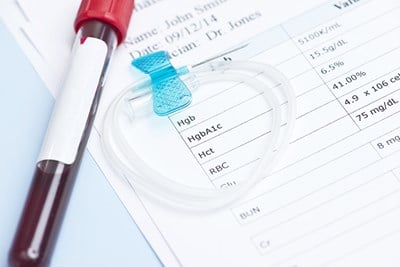The A1C test is a useful tool for checking blood sugar levels in patients. It measures the amount of glucose (sugar) attached to hemoglobin (a protein in red blood cells), and converts it into a percentage. But there are several tests that check for diabetes, and they don’t all follow the same system of measurements. Here’s a look at what your A1C test means.
Diagnosing and Managing Diabetes with the A1C
The A1C test isn’t just used in patients who already know they have diabetes. If you’re concerned about your lifestyle, family medical history, or suspicious symptoms, your doctor may use the A1C test to see where you fall on the scale. The lower your percentage, the better.
Although the American Diabetes Association states that a score below 7% indicates diabetes is not present, according to the National Institute of Health, that score should be below 5.4%. Between 5.5% and 6.4% can be an indicator of prediabetes—the higher the percentage, the more likely it is full blown diabetes of either type will develop.
There’s usually a span of about ten years during which prediabetes may develop, but a serious change of diet and exercise can help put that off or even stop it. Above 6.5% is usually indicative of diabetes, and it’s time to take action.
If a patient scores in the prediabetic range, it’s usually a good idea to take the A1C test yearly. For those with a diagnosis of diabetes, a twice a year A1C test can help see their three-month blood sugar level average to determine how well the management process is going and if some adjustments may be needed.
Accuracy of the A1C
The A1C test has come a long way over the years. The National Glycohemoglobin Standardization Program (NGSP) has taken steps to improve accuracy and standardization. Although there are false positives and a potential for a .5% miscount, the NGSP provides physicians with the ability to see exactly how accurate (or inaccurate) the type of test they use may be, which in turn allows patients more accurate information. And although a half percent may not seem like much, it might be the difference in changing your diet to fend of diabetes over the next decade.
A1C and the eAG
With so many different types of testing on the market, it can be confusing trying to get an understanding of what the scores mean. If you already know you are diabetic and are using the A1C test to monitor your blood sugar levels, you might wonder how those scores compare to your daily blood sugar levels. The A1C may be reported as an eAG, meaning “average glucose,” which is very different from your normal monitoring numbers.
The difference is in the key word “average.” While you measure your blood glucose levels at a particular point in time, the A1C gives your eAG over an extended period of full days. The American Diabetes Association offers a helpful tool for translating your eAG into a number more comparable to that of your daily blood sugar levels.



